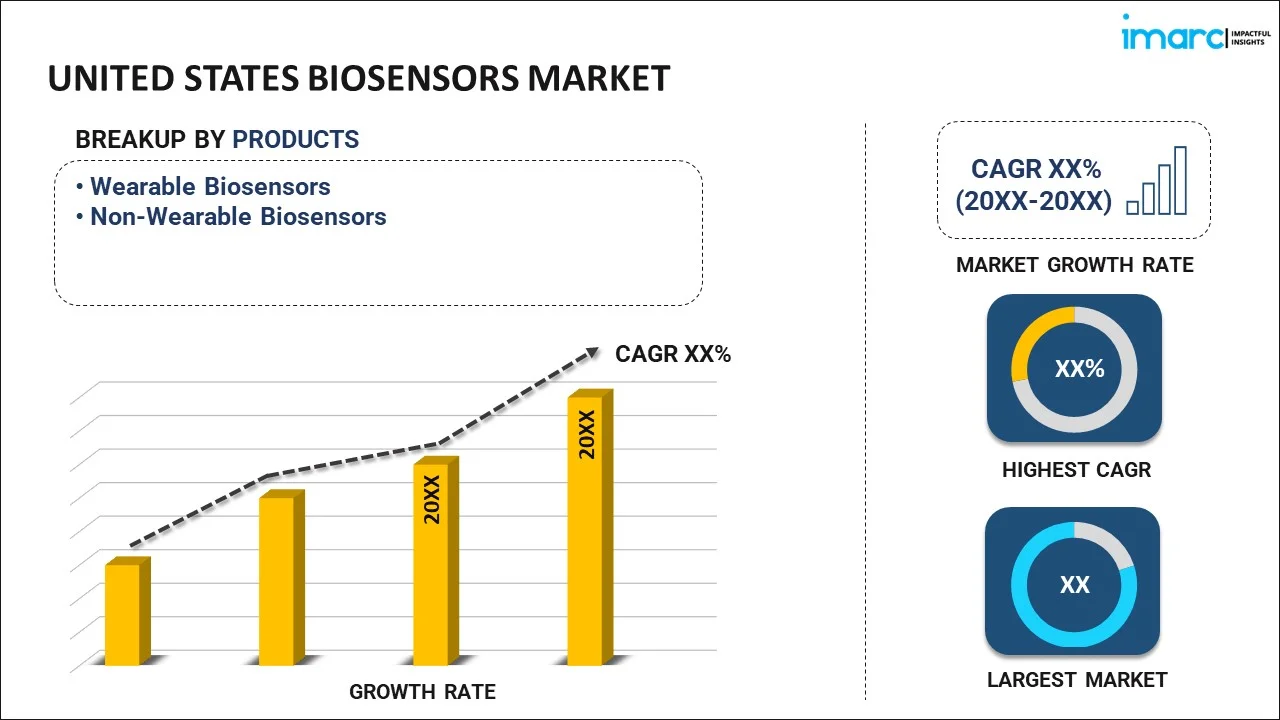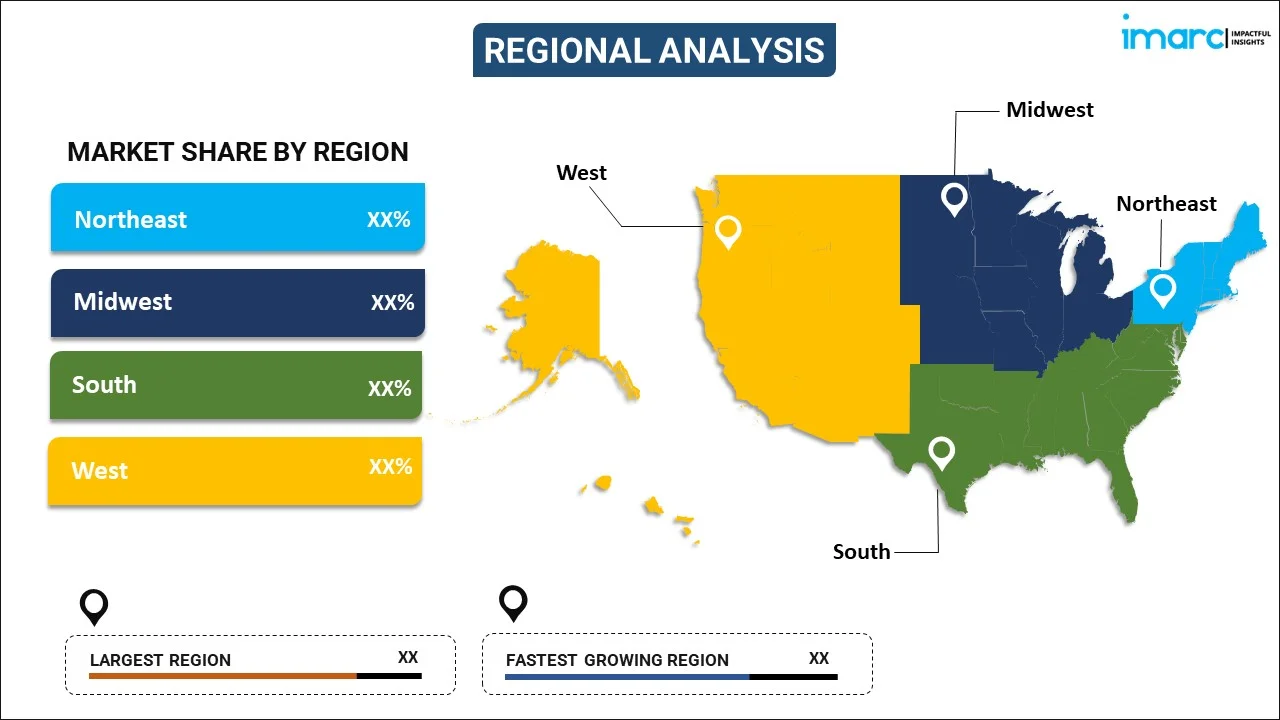
United States Biosensors Market Report by Product (Wearable Biosensors, Non-Wearable Biosensors), Technology (Electrochemical Biosensors, Optical Biosensors, Piezoelectric Biosensors, Thermal Biosensors, Nanomechanical Biosensors, and Others), Application (Blood Glucose Testing, Cholesterol Testing, Blood Gas Analysis, Pregnancy Testing, Drug Discovery, Infectious Disease Testing, and Others), End Use (Point of Care Testing, Home Healthcare Diagnostics, Research Laboratories, Security and Biodefense, and Others), and Region 2025-2033
Market Overview:
United States biosensors market size is projected to exhibit a growth rate (CAGR) of 7.99% during 2025-2033. The increasing demand for rapid and accurate diagnostic tools, the growing need for point-of-care testing, the development of miniaturized and wearable biosensors, and the escalating demand for biosensors represent some of the key factors driving the market.
|
Report Attribute
|
Key Statistics
|
|---|---|
|
Base Year
|
2024 |
|
Forecast Years
|
2025-2033 |
|
Historical Years
|
2019-2024
|
| Market Growth Rate (2025-2033) | 7.99% |
Biosensors are innovative devices designed to detect specific biological molecules or markers, providing valuable information about various biological processes, health conditions, and environmental factors. These advanced instruments have revolutionized fields such as healthcare, diagnostics, and environmental monitoring due to their precision, sensitivity, and versatility. They have the ability to rapidly and accurately detect specific biological molecules, such as proteins, DNA, or enzymes. This capability makes them invaluable tools in medical diagnostics, where they can be used to identify biomarkers associated with diseases, infections, or various health conditions. Biosensors enable early and precise diagnosis, leading to more effective treatment and improved patient outcomes. They come in various forms and can be tailored to detect a wide range of biological substances. They can be used to monitor glucose levels in diabetes management, detect specific pathogens in food safety testing, or even identify environmental pollutants in real time. Their adaptability and specificity make them indispensable in diverse applications. Additionally, they provide rapid results, which is critical in emergency medical situations, environmental monitoring, and various research applications. This speed allows for quick decision-making and intervention when necessary.
United States Biosensors Market Trends:
The United States biosensors market is primarily driven by the increasing demand for rapid and accurate diagnostic tools. Biosensors, which can quickly and precisely detect specific biological markers or molecules, are critical in diagnosing diseases, monitoring patient health, and conducting research in the medical field. Moreover, the healthcare sector’s continuous advancements and the need for point-of-care testing have significantly contributed to the growth of the biosensors market. Biosensors are widely used in hospitals, clinics, and laboratories for applications such as glucose monitoring, infectious disease detection, and cancer biomarker analysis. The demand for biosensors in remote and resource-limited settings further augments the market growth, as these devices offer portable and cost-effective diagnostic solutions. Furthermore, the biotechnology industry also relies heavily on biosensors for various applications, including drug discovery, bioprocessing, and biomolecule analysis. Biosensors enable real-time monitoring of biological processes, facilitating more efficient and accurate research and development activities. Environmental monitoring and food safety are additional drivers of the biosensors market. Biosensors can detect pollutants, toxins, and contaminants in air, water, and food, ensuring the safety and quality of these essential resources. Apart from this, the increasing focus on environmental sustainability and public health further elevates the importance of biosensors in these applications. Government investments and research funding in biosensor technology contribute to market growth. Public and private institutions are actively supporting research and development initiatives to advance biosensor capabilities, expand their applications, and enhance their accessibility. Continual technological advancements, including the development of miniaturized and wearable biosensors, have expanded the reach and functionality of biosensors.
United States Biosensors Market Segmentation:
IMARC Group provides an analysis of the key trends in each segment of the market, along with forecasts at the country level for 2025-2033. Our report has categorized the market based on product, technology, application, and end use.
Product Insights:

- Wearable Biosensors
- Non-Wearable Biosensors
The report has provided a detailed breakup and analysis of the market based on the product. This includes wearable biosensors and non-wearable biosensors.
Technology Insights:
- Electrochemical Biosensors
- Optical Biosensors
- Piezoelectric Biosensors
- Thermal Biosensors
- Nanomechanical Biosensors
- Other
A detailed breakup and analysis of the market based on the technology have also been provided in the report. This includes electrochemical biosensors, optical biosensors, piezoelectric biosensors, thermal biosensors, nanomechanical biosensors, and others.
Application Insights:
- Blood Glucose Testing
- Cholesterol Testing
- Blood Gas Analysis
- Pregnancy Testing
- Drug Discovery
- Infectious Disease Testing
- Others
The report has provided a detailed breakup and analysis of the market based on the application. This includes blood glucose testing, cholesterol testing, blood gas analysis, pregnancy testing, drug discovery, infectious disease testing, and others.
End Use Insights:
- Point of Care Testing
- Home Healthcare Diagnostics
- Research Laboratories
- Security and Biodefense
- Others
A detailed breakup and analysis of the market based on the end use have also been provided in the report. This includes point of care testing, home healthcare diagnostics, research laboratories, security and biodefense, and others.
Regional Insights:

- Northeast
- Midwest
- South
- West
The report has also provided a comprehensive analysis of all the major regional markets, which include Northeast, Midwest, South, and West.
Competitive Landscape:
The market research report has also provided a comprehensive analysis of the competitive landscape. Competitive analysis such as market structure, key player positioning, top winning strategies, competitive dashboard, and company evaluation quadrant has been covered in the report. Also, detailed profiles of all major companies have been provided.
United States Biosensors Market Report Coverage:
| Report Features | Details |
|---|---|
| Base Year of the Analysis | 2024 |
| Historical Period | 2019-2024 |
| Forecast Period | 2025-2033 |
| Units | Million USD |
| Scope of the Report | Exploration of Historical Trends and Market Outlook, Industry Catalysts and Challenges, Segment-Wise Historical and Future Market Assessment:
|
| Products Covered | Wearable Biosensors, Non-Wearable Biosensors |
| Technologies Covered | Electrochemical Biosensors, Optical Biosensors, Piezoelectric Biosensors, Thermal Biosensors, Nanomechanical Biosensors, Others |
| Applications Covered | Blood Glucose Testing, Cholesterol Testing, Blood Gas Analysis, Pregnancy Testing, Drug Discovery, Infectious Disease Testing, Others |
| End Uses Covered | Point of Care Testing, Home Healthcare Diagnostics, Research Laboratories, Security and Biodefense, Others |
| Regions Covered | Northeast, Midwest, South, West |
| Customization Scope | 10% Free Customization |
| Post-Sale Analyst Support | 10-12 Weeks |
| Delivery Format | PDF and Excel through Email (We can also provide the editable version of the report in PPT/Word format on special request) |
Key Questions Answered in This Report:
- How has the United States biosensors market performed so far and how will it perform in the coming years?
- What has been the impact of COVID-19 on the United States biosensors market?
- What is the breakup of the United States biosensors market on the basis of product?
- What is the breakup of the United States biosensors market on the basis of technology?
- What is the breakup of the United States biosensors market on the basis of application?
- What is the breakup of the United States biosensors market on the basis of end use?
- What are the various stages in the value chain of the United States biosensors market?
- What are the key driving factors and challenges in the United States biosensors?
- What is the structure of the United States biosensors market and who are the key players?
- What is the degree of competition in the United States biosensors market?
Key Benefits for Stakeholders:
- IMARC’s industry report offers a comprehensive quantitative analysis of various market segments, historical and current market trends, market forecasts, and dynamics of the United States biosensors market from 2019-2033.
- The research report provides the latest information on the market drivers, challenges, and opportunities in the United States biosensors market.
- Porter's five forces analysis assist stakeholders in assessing the impact of new entrants, competitive rivalry, supplier power, buyer power, and the threat of substitution. It helps stakeholders to analyze the level of competition within the United States biosensors industry and its attractiveness.
- Competitive landscape allows stakeholders to understand their competitive environment and provides an insight into the current positions of key players in the market.
Need more help?
- Speak to our experienced analysts for insights on the current market scenarios.
- Include additional segments and countries to customize the report as per your requirement.
- Gain an unparalleled competitive advantage in your domain by understanding how to utilize the report and positively impacting your operations and revenue.
- For further assistance, please connect with our analysts.
 Inquire Before Buying
Inquire Before Buying
 Speak to an Analyst
Speak to an Analyst
 Request Brochure
Request Brochure
 Request Customization
Request Customization




.webp)




.webp)












